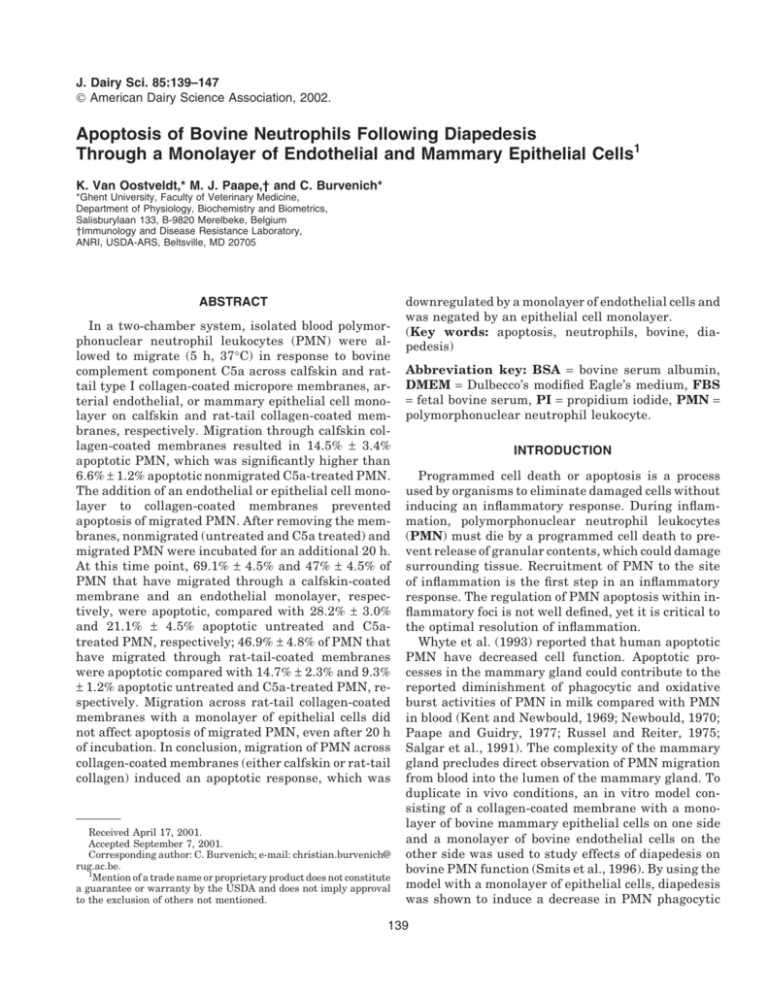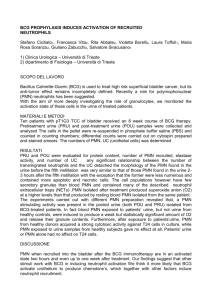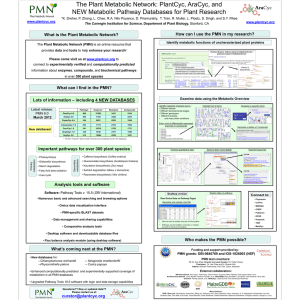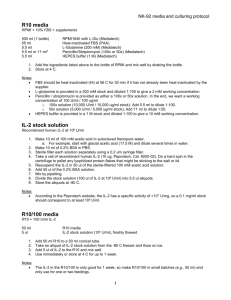Open Access
advertisement

J. Dairy Sci. 85:139–147 American Dairy Science Association, 2002. Apoptosis of Bovine Neutrophils Following Diapedesis Through a Monolayer of Endothelial and Mammary Epithelial Cells1 K. Van Oostveldt,* M. J. Paape,† and C. Burvenich* *Ghent University, Faculty of Veterinary Medicine, Department of Physiology, Biochemistry and Biometrics, Salisburylaan 133, B-9820 Merelbeke, Belgium †Immunology and Disease Resistance Laboratory, ANRI, USDA-ARS, Beltsville, MD 20705 ABSTRACT In a two-chamber system, isolated blood polymorphonuclear neutrophil leukocytes (PMN) were allowed to migrate (5 h, 37°C) in response to bovine complement component C5a across calfskin and rattail type I collagen-coated micropore membranes, arterial endothelial, or mammary epithelial cell monolayer on calfskin and rat-tail collagen-coated membranes, respectively. Migration through calfskin collagen-coated membranes resulted in 14.5% ± 3.4% apoptotic PMN, which was significantly higher than 6.6% ± 1.2% apoptotic nonmigrated C5a-treated PMN. The addition of an endothelial or epithelial cell monolayer to collagen-coated membranes prevented apoptosis of migrated PMN. After removing the membranes, nonmigrated (untreated and C5a treated) and migrated PMN were incubated for an additional 20 h. At this time point, 69.1% ± 4.5% and 47% ± 4.5% of PMN that have migrated through a calfskin-coated membrane and an endothelial monolayer, respectively, were apoptotic, compared with 28.2% ± 3.0% and 21.1% ± 4.5% apoptotic untreated and C5atreated PMN, respectively; 46.9% ± 4.8% of PMN that have migrated through rat-tail-coated membranes were apoptotic compared with 14.7% ± 2.3% and 9.3% ± 1.2% apoptotic untreated and C5a-treated PMN, respectively. Migration across rat-tail collagen-coated membranes with a monolayer of epithelial cells did not affect apoptosis of migrated PMN, even after 20 h of incubation. In conclusion, migration of PMN across collagen-coated membranes (either calfskin or rat-tail collagen) induced an apoptotic response, which was Received April 17, 2001. Accepted September 7, 2001. Corresponding author: C. Burvenich; e-mail: christian.burvenich@ rug.ac.be. 1 Mention of a trade name or proprietary product does not constitute a guarantee or warranty by the USDA and does not imply approval to the exclusion of others not mentioned. downregulated by a monolayer of endothelial cells and was negated by an epithelial cell monolayer. (Key words: apoptosis, neutrophils, bovine, diapedesis) Abbreviation key: BSA = bovine serum albumin, DMEM = Dulbecco’s modified Eagle’s medium, FBS = fetal bovine serum, PI = propidium iodide, PMN = polymorphonuclear neutrophil leukocyte. INTRODUCTION Programmed cell death or apoptosis is a process used by organisms to eliminate damaged cells without inducing an inflammatory response. During inflammation, polymorphonuclear neutrophil leukocytes (PMN) must die by a programmed cell death to prevent release of granular contents, which could damage surrounding tissue. Recruitment of PMN to the site of inflammation is the first step in an inflammatory response. The regulation of PMN apoptosis within inflammatory foci is not well defined, yet it is critical to the optimal resolution of inflammation. Whyte et al. (1993) reported that human apoptotic PMN have decreased cell function. Apoptotic processes in the mammary gland could contribute to the reported diminishment of phagocytic and oxidative burst activities of PMN in milk compared with PMN in blood (Kent and Newbould, 1969; Newbould, 1970; Paape and Guidry, 1977; Russel and Reiter, 1975; Salgar et al., 1991). The complexity of the mammary gland precludes direct observation of PMN migration from blood into the lumen of the mammary gland. To duplicate in vivo conditions, an in vitro model consisting of a collagen-coated membrane with a monolayer of bovine mammary epithelial cells on one side and a monolayer of bovine endothelial cells on the other side was used to study effects of diapedesis on bovine PMN function (Smits et al., 1996). By using the model with a monolayer of epithelial cells, diapedesis was shown to induce a decrease in PMN phagocytic 139 140 OOSTVELDT ET AL. and respiratory burst activities (Smits et al., 1999). The relationship between diapedesis, bovine PMN apoptosis, and the observed decrease in PMN function remains to be characterized. The objective of this study was to determine the effects of migration of bovine PMN across membranes consisting of collagen matrix, endothelial cells, or epithelial cells on apoptosis of the PMN. The two-chamber system of Smits et al. (1996) was used as an in vitro model for the study of PMN migration. Because the extent of apoptosis of milk PMN in vivo is probably modulated by the blood-milk barrier, which consists of different layers, we hypothesized that migration through each layer separately might have different effects on apoptosis of migrating PMN. MATERIALS AND METHODS Reagents Dulbecco’s modified Eagle’s medium (DMEM), fetal bovine serum (FBS), Ham’s F12 mixture, and RPMI were purchased from Life Technologies, Ltd., Paisley, Scotland, UK. Antibiotic-antimycotic solution, bovine insulin, bovine serum albumin (BSA), collagenase type III, calfskin collagen, HEPES buffer, hydrocortisone, propidium iodide (PI), rat-tail collagen, sodium acetate, sodium citrate, sodium pyruvate, Triton X100, and trypsin were purchased from Sigma, St. Louis, MO. Hemacolor was purchased from Merck, D64293 Darmstadt 1, Germany. Isolation and Preparation of PMN Mid-lactating cows were chosen as donors for the isolation of PMN from blood. Blood was collected aseptically from the external jugular vein in Vacutainer tubes (Laboratoire EGA, Nogent-Le-Roi, France) containing 125 IU heparin as anticoagulant. Blood was processed within 0.5 h of collection. The PMN were isolated from blood according to the method described by Carlson and Kaneko (1973) with slight modifications. In brief, 40 ml of blood was centrifuged for 15 min at 200 × g followed by removal of the plasma and buffy coat. Red blood cells were lysed by adding 20 ml of sterile pyrogen-free distilled water to the remaining 10 ml of blood for 45 s. Isotonicity was restored by addition of 10 ml of 2.7% saline. After centrifugation for 5 min at 200 × g, the cell pellet was resuspended in 10 ml of sterile 0.01 M phosphate-buffered 0.85% saline, pH 7.4, followed by a second lysis with distilled water. The cell pellet was resuspended in 1 ml of medium (1:1 RPMI/DMEM with 0.1% BSA). Cells were counted with an electronic cell counter (Coulter Electronics Ltd., Luton, LU 33RH, UK). Smears were preJournal of Dairy Science Vol. 85, No. 1, 2002 pared from isolated cells and stained with Hemacolor. Differential leukocyte counts were determined microscopically by counting 100 cells. Viability or necrosis was determined by flow cytometry (FACSscan; Becton Dickinson Immunocytometry Systems, San Jose, CA) by using a PI exclusion test. Purity and viability of the isolated PMN was >90 and >95%, respectively. Cells were adjusted to a concentration of 107 viable PMN/ml. Cell Culture System In this study, the following three in vitro models were used to study the effect of migration or diapedesis on PMN apoptosis: 1) membrane insert (12 mm diameter, 3 µm pore size; Millicell-PCF; Millipore, Bedford, MA) coated with 1% calfskin collagen (type I) or with 0.6% rat-tail collagen (type I) (Figure 1A), 2) membrane insert coated with 1% calfskin collagen (type I) and a monolayer of bovine mammary arterial endothelial cells (Figure 1B), and 3) membrane insert coated with 0.6% rat-tail collagen (type I) and a monolayer of bovine mammary ductular epithelial cells (Figure 1C). Membrane inserts were coated either with 1% calfskin collagen type I for 48 h at 4°C or with 0.6% rat-tail type I collagen overnight at room temperature (Figure 1A). Culture of Mammary Endothelial Cells Bovine mammary endothelial cells were harvested by trypsin digestion of the endothelium of the mammary artery, according to Aherne et al. (1995) and Smits et al. (1996). Endothelial cells were grown to confluence in 44% DMEM, 44% Ham’s F12 nutrient mixture, 10% FBS, and 2% antibiotic-antimycotic solution at 37°C in 95% air-5% CO2. Primary endothelial cells were added to membrane inserts (1-2 ×105/insert) precoated with 1% calfskin collagen type I, as described above, and incubated for 7 d at 37°C in 95% air-5% CO2 (Figure 1B). Endothelial cell growth on the membrane inserts was monitored by using confocal microscopy. Culture of Mammary Epithelial Cells Bovine mammary ductular epithelial cells were harvested by collagenase digestion of large ducts dissected from fresh mammary tissue and purified as previously described by Cifrian et al. (1994). Culture medium for epithelial cells contained 44% RPMI 1640, 44% DMEM, 10% FBS, 2% antibiotic-antimycotic solution, 1 mM sodium pyruvate, 10 mM sodium acetate, 40 mM HEPES buffer, 5 µg/ml bovine insulin, and 1 BOVINE NEUTROPHIL APOPTOSIS 141 Figure 1. In vitro models used to study the effect of diapedesis on polymorphonuclear neutrophil leukocyte apoptosis. A) Membrane insert (12 mm diameter, 3 µm pore size; Millicell-PCF (Millipore, Bedford, MA) coated with 1% calfskin collagen (type I) or with 0.6% rattail collagen (type I). B) Membrane insert coated with 1% calfskin collagen (type I) and a monolayer of bovine mammary endothelial arterial cells. C) Membrane insert coated with 0.6% rat-tail collagen (type I) and a monolayer of bovine mammary ductular epithelial cells. Journal of Dairy Science Vol. 85, No. 1, 2002 142 OOSTVELDT ET AL. µg/ml hydrocortisone. Rat-tail collagen type I-coated inserts were inverted in six-well plates containing culture medium. Primary ductular epithelial cells were added to the inverted inserts (5 × 104/insert) and incubated at 37°C in 95% air-5% CO2 for a minimum of 10 d (Figure 1C). Trials were performed to grow epithelial cells on calfskin collagen-coated membrane inserts; however, a bad growth of epithelial cells on this type of collagen was determined. Therefore, only rattail collagen-coated membrane inserts were used. Confluence of the epithelial monolayer was determined by measuring the transepithelial electrical resistance with an ohmmeter (Millipore). Only monolayers with a resistance > 1000 Ω/cm2 were used. PMN Diapedesis The diapedesis assay was previously described (Smits et al., 1996). The endothelial and epithelial cell monolayers and the collagen-coated inserts were rinsed in medium (1:1 RPMI/DMEM with 0.1% BSA) to remove culture medium and residual serum components. The PMN (200µl, 107/ml) were added to the upper chamber (Figure 1) and 50 ng/ml of the chemoattractant bovine complement component C5a (kindly provided by Dr. Pascal Rainard, INRA, Nouzilly, France) was added to the lower chamber and incubated for 5 h at 37°C in 95% air-5% CO2. PMN were collected from the lower chamber of six wells and pooled. An aliquot was removed for counting the diapedesed PMN in triplicate by using a hemocytometer and for flow cytometric analysis of apoptosis and necrosis. The remaining PMN from the lower chambers were incubated for an additional 20 h at 37°C in 95% air-5% CO2 in the absence of the membrane inserts before flow cytometric analysis. This assay was repeated for at least four cows. Immediately after PMN isolation, controls (untreated and C5a-treated PMN) were prepared by incubating PMN for 5 h and an additional 20 h in RPMI/DMEM (1:1) with 0.1% BSA in the absence or presence of C5a (50 ng/ml), respectively. It is noteworthy that the percentage of apoptotic and necrotic PMN were determined in the lower chambers and in the controls (untreated PMN and C5a-treated PMN) that were never brought on the membrane inserts. We were unable to determine the extent of apoptosis and necrosis in the upper chambers. This implies that for each experiment using the respective diapedesis models, three populations of PMN were compared immediately after migration, which lasts for 5 h (time 0 h), and 20 h later, which makes a total incubation time for the controls of 25 h. To study the effect of the addition of an endothelial or epithelial monolayer to the collagen-coated memJournal of Dairy Science Vol. 85, No. 1, 2002 brane inserts on apoptosis and necrosis of PMN that migrate through the membrane inserts, the apoptotic response of PMN migrated through calfskin- and rattail-coated inserts is compared with PMN migrated through collagen-coated inserts with a monolayer of endothelial and epithelial cells, respectively. Quantitative Flow Cytometric Detection of Apoptosis PMN apoptosis was assessed by flow cytometry according to the method of Nicoletti et al. (1991) with modifications. In brief, PMN (105 cells/ml) were incubated with 500 µl of Triton solution (50 µg/ml PI, 0.1% sodium citrate, 0.1% Triton X-100, and 10% FCS) in the dark at 4°C for 1 h before they were analyzed by flow cytometry, with linear amplification of the forward scatter and side scatter light signals and with logarithmic amplification of the fluorescence signals. The laser was set at 488 nm wavelength. For each sample, a minimum of 5000 events was collected. The PI fluorescence of individual nuclei was measured on the FL3 photon multiplier. Nuclei of apoptotic and normal PMN were distinguished by their hypodiploid and diploid DNA content, respectively. The PMN debris was excluded from analysis by raising the forward scatter threshold. Because the purity of PMN was >90% in all samples, no gates were set. All measurements were performed under the same conditions and instrument settings. Data were acquired and processed by using CELLQuest software (Becton Dickinson). Morphologic Evaluation The PMN incubated under specific conditions as described above were stained with Hemacolor and the number of apoptotic cells were determined by light microscopy (magnification 1000×). One hundred cells were examined on each of three slides. Apoptotic PMN were characterized as cells with either a condensed or a picnotic nucleus. Statistical Analyses For all statistical procedures, mean and standard error of the mean values were computed by using statistical software (Statistix NH Analytical Software; Tallahassee, FL) according to Snedecor and Cochran (1968). Results are expressed as mean values plus or minus standard error of the mean values. Normality was tested by using the Wilk-Shapiro test. Statistical analysis was performed by using ANOVA with treatment (C5a stimulated, nonstimulated, and migrated 143 BOVINE NEUTROPHIL APOPTOSIS Figure 2. Effect of migration through collagen type I (calfskin)coated membrane inserts on polymorphonuclear neutrophil leukocyte (PMN) apoptosis. Apoptosis was assessed by flow cytometry in untreated, C5a-treated PMN, and PMN migrated in response to C5a. Percentages of apoptotic PMN were determined immediately after migration (0 h) and after an additional incubation period in the presence of C5a but in the absence of the membrane inserts (20 h) and compared with percentages of apoptotic PMN determined in the untreated and C5a-treated PMN controls. Data are mean ± SEM values of experiments on four at-random chosen cows. Figure 3. Effect of migration through collagen type I (rat tail)coated membrane inserts on polymorphonuclear neutrophil leukocyte (PMN) apoptosis. Apoptosis was assessed by flow cytometry in untreated, C5a-treated PMN, and PMN migrated in response to C5a. Percentages of apoptotic PMN were determined immediately after migration (0 h) and after an additional incubation period in the presence of C5a but in the absence of the membrane inserts (20 h) and compared with percentages of apoptotic PMN determined in the untreated and C5a-treated PMN controls. Data are mean ± SEM values of experiments on eight at-random chosen cows. PMN) as fixed factors, cows as the randomized factor, and treatment × cow as the interaction. Least significant difference was used to compare mean values. Statistical significance was accepted at P < 0.05 (*), P < 0.01 (**), and P < 0.001 (***). coated membrane inserts compared with C5a-stimulated PMN (Figure 3). The percentage of necrotic PMN (<10%) was also not affected after migration (data not shown). However, in the PMN population that was migrated across the rat-tail collagen-coated membrane inserts and that was incubated for an additional 20 h in the absence of the membrane inserts, 46.9% ± 4.8% PMN were apoptotic. This percentage was significantly higher than the percentage of apoptotic PMN in the untreated PMN population (14.7% ± 2.3%) and in the C5a-treated population (9.3% ± 1.2%) that has not been migrated. After 20 h of incubation, the percentage of necrotic PMN increased to a maximum of 24.3%. However, at this time, the percentage of necrotic PMN in the migrated PMN population was not significantly different from the percentages of necrotic PMN in the untreated and C5a-treated PMN population. RESULTS Collagen Type I Matrix on Membrane Inserts At the end of the initial 5-h incubation, higher percentages of apoptotic PMN were detected in the migrated PMN (14.5% ± 3.4%) through calfskin collagencoated membrane inserts compared with C5a-treated nonmigrated PMN (6.6% ± 1.2%) (P < 0.01) (Figure 2). The percentage of necrotic PMN was not affected by migration and remained <10% (data not shown). After an additional incubation period of 20 h, 28.2% ± 3.0% of the untreated PMN and 21.2% ± 1.9% of C5a-treated PMN were apoptotic. Migrated PMN that were incubated in medium containing C5a for an additional 20 h after removing the insert showed 69.1% ± 4.5% apoptosis (Figure 2). Comparison of C5a-treated with untreated PMN (Figure 2) shows that C5a had an apoptosis-retarding effect (P < 0.01). The percentage of necrotic PMN in the migrated PMN population (26%) was increased (P < 0.01) after an additional 20h incubation period in the absence of the membrane insert. No differences in percentages of necrotic PMN were determined between the migrated, untreated, and C5a-treated PMN population (results not shown). Apoptosis of PMN was not affected immediately after migration through rat-tail collagen (type I)- Mammary Endothelial Cells on Calfskin Collagen (Type I)-Coated Membrane Inserts Immediately after migration through calfskin collagen-coated membrane inserts with a monolayer of primary endothelial cells, no differences in the percentages of apoptotic PMN in the migrated, untreated, and C5a-treated PMN population were determined (Figure 4). The percentage of necrotic PMN (<10%) was also not affected after migration (data not shown). Incubating the migrated PMN for an additional 20 h accelerated PMN apoptosis (47.5% ± 3.0%) compared with untreated PMN (28.2% ± 3.0%) or C5a-treated PMN (21.2% ± 1.9%) (Figure 4). However, the percentage of PMN that was identified as apoptotic after miJournal of Dairy Science Vol. 85, No. 1, 2002 144 OOSTVELDT ET AL. Figure 4. Effect of migration through collagen type I (calfskin)coated membrane inserts with a monolayer of endothelial cells on polymorphonuclear neutrophil leukocyte (PMN) apoptosis. Apoptosis was assessed by flow cytometry in untreated, C5a-treated PMN, and PMN migrated in response to C5a. Percentages of apoptotic PMN were determined immediately after migration (0 h) and after an additional incubation period in the presence of C5a but in the absence of the membrane inserts (20 h) and compared with percentages of apoptotic PMN determined in the untreated and C5a-treated PMN controls. Data are mean ± SEM values of experiments on seven atrandom chosen cows. Figure 5. Effect of migration through collagen type I (rat tail)coated membrane inserts with a monolayer of epithelial cells on polymorphonuclear neutrophil leukocyte (PMN) apoptosis. Apoptosis was assessed by flow cytometry in untreated, C5a-treated PMN, and PMN migrated in response to C5a. Percentages of apoptotic PMN were determined immediately after migration (0 h) and after an additional incubation period in the presence of C5a but in the absence of the membrane inserts (20 h) and compared with percentages of apoptotic PMN determined in the untreated and C5a-treated PMN controls. Data are mean ± SEM values of experiments on eight at-random chosen cows. gration through the collagen-coated membrane inserts with a monolayer of endothelial cells (47.5% ± 3.0%) was lower (P < 0.01) than the percentage of apoptotic PMN (69.1% ± 4.5%) in the PMN population that was migrated through collagen-coated membrane inserts only (Figures 2 and 4). ure 6). A higher percentage of PMN with a condensed nucleus were detected in the migrated PMN population than in the nonmigrated C5a-treated PMN population. DISCUSSION Mammary Epithelial Cells on Rat-Tail Collagen (Type I)-Coated Membrane Inserts Immediately after migration through rat-tail collagen-coated membrane inserts with a monolayer of mammary epithelial cells, no differences in the percentages of apoptotic PMN in the migrated, untreated, and C5a-treated PMN population were determined (Figure 5). The percentage of necrotic PMN was not affected after migration and remained <10% (data not shown). Incubating the migrated PMN for an additional 20 h in the absence of the membrane inserts also did not significantly affect PMN apoptosis compared with untreated or C5a-treated controls (Figure 5). At this time, the percentages of necrotic PMN remained <10% (data not shown). Morphological Evaluation The results obtained by flow cytometry were confirmed by light microscopy (data not shown). Light microscopy is routinely used as a qualitative control of the flow cytometric method for determining apoptosis. Representative micrographs of C5a-treated PMN that have not been migrated and PMN that migrated across a rat-tail collagen-coated membrane inserts and incubated for an additional 20 h are shown (FigJournal of Dairy Science Vol. 85, No. 1, 2002 The ability to mount a rapid and effective immunological response to infection is critical in protecting the mammary gland from damage caused by invading pathogens. Rapid migration of PMN through the blood-milk barrier toward chemoattractants in the mammary gland is essential for rapid resolution of the infection. Equally important, but less well understood, is the ability to terminate the inflammatory response once the infection has been cleared. Studies have shown that once PMN migrate out of the circulatory system they die spontaneously by apoptosis and are recognized by macrophages and cleared from the site of infection (Savill, 1997). Different mechanisms have been described for several cell types by which phagocytes recognize apoptotic cells (Fadok et al., 1992; Flora and Gregory, 1994; Puento Navazo et al., 1996; Savill, 1996, 1997; Savill et al., 1992, 1993). By using electron microscopy, Sládek and Rys̆ánek (2000) were the first to show that apoptotic PMN are phagocytosed by macrophages in the bovine mammary gland. In this study, apoptosis of PMN after migration across endothelium, collagen matrix, and ductular mammary epithelium was investigated. Monolayers of primary mammary endothelial and epithelial cells on a porous membrane were used to represent the in BOVINE NEUTROPHIL APOPTOSIS 145 Figure 6. Morphological analysis of control polymorphonuclear neutrophil leukocyte (PMN) incubated with C5a for 25 h showing lower percentages of PMN with morphological features of apoptosis (A) than PMN that have migrated through rat-tail collagen-coated membrane inserts in response to C5a and incubated for an additional 20 h after migration (B). The arrows indicate apoptotic PMN. Bar = 10 µm. vivo blood-milk barrier. Collagen-coated membranes were used to represent the extracellular matrix. This is the first report showing that the proportion of PMN that were apoptotic was greater in PMN that had migrated than in PMN that had not migrated and this is differentially regulated by the tissues that they migrate through. In this study, C5a had a retarding effect on PMN apoptosis after a 25-h incubation period, which is in agreement with Lee et al. (1993). Therefore, we determined the percentage of apoptotic PMN in the migrated PMN population and compared the response with the nonmigrated C5a-activated PMN population. Migration of bovine PMN through calfskin collagencoated membrane inserts resulted in a more rapid apoptotic response compared with PMN that migrated through endothelial cells. In contrast, migration of bovine PMN through rat-tail collagen-coated membrane inserts did not affect apoptosis immediately after migration. However, higher percentages of apoptotic PMN were detected after an additional incubation period of 20 h in the PMN that had migrated through rat-tail collagen-coated inserts compared with PMN that had not migrated and were incubated with C5a alone for the full 25 h. Although both kinds of collagens were members of the collagen type I family, the different effects on PMN apoptosis after a 5h migration may be due to the difference in dilutions of collagen used to coat the membrane inserts. Rattail collagen-coated membrane inserts were chosen to cultivate on epithelial cells, which were not able to grow on the calfskin-coated membrane inserts. Both collagen types were diluted in 0.01 N acetic acid. Calfskin and rat-tail collagen dilutions were 1% and 0.6%, respectively, which caused a difference in pH and may affect apoptosis to a different extent. However, the PMN apoptosis-inducing effect after migration through a collagen-coated membrane insert, regardless of the source of collagen, might be ascribed to the involvement of adhesion receptors such as L-selectin and β2-integrins. Iwabuchi et al. (1996) reported that L-selectin plays a role in PMN binding to type IV collagen. Observations about the involvement of Lselectin in PMN binding to type I collagen have not been published. Watson et al. (1997) reported that cross-linking of L-selectin with anti-Dreg 56 monoclonal antibody resulted in a significant increase in human PMN apoptotic rates. Migration across the extracellular matrix involves the β2-integrin CD18 receptor without participation of the CD11b receptor (Smits et al., 2000). In contrast to the effects of Lselectin, cross-linking of the β-chain of the β2-integrins (CD18) failed to alter apoptotic rates in human PMN (Walzog et al., 1997; Watson et al., 1997). Therefore, our results suggest that L-selectin might play an important role in the PMN apoptosis-inducing effect after in vitro migration through collagen-coated membrane inserts. Indeed, CD18 comprised only 55% of the bovine PMN that migrated through collagen (Smits et al., 2000); and, therefore, one or more CD18-independent mechanism might be responsible for the induction of apoptosis after migration across collagen. The apoptosis-inducing effect on PMN migration through collagen-coated membrane inserts was negated by the addition of a monolayer of endothelial cells. However, the apoptosis-inducing effect of PMN migration through a monolayer of endothelial cells was observed after the additional 20-h incubation period. This is in agreement with the results of Watson et al. (1997), who reported that human PMN apoptotic rates were accelerated after additional 5-, 18-, and 24-h incubation periods after PMN migration across Journal of Dairy Science Vol. 85, No. 1, 2002 146 OOSTVELDT ET AL. a monolayer of endothelial cells. In our study, the percentages of apoptotic PMN were greater after PMN migration through calfskin collagen and after incubation for 20 h compared with PMN that migrated through endothelial cells (Figures 1 and 3). The role of β2-integrins on PMN migration across the extracellular matrix (e.g., collagen) is distinct from that on PMN migration through vascular endothelium. The integrins CD11b/CD18 on PMN play an essential role in the migration of bovine PMN across primary mammary endothelial cells in response to C5a, whereas CD11b was not involved in the PMN migration across collagen. Watson et al. (1997) reported that cross-linking CD11b significantly delayed apoptosis of resting PMN. This could explain why the expression of apoptosis was less affected after migration across a monolayer of endothelial cells compared with PMN migration through collagen. Apoptotic rates of PMN that have migrated through an epithelial monolayer were not different from apoptotic rates of PMN that were incubated with C5a alone. Migration of PMN through an epithelial barrier involves CD11b and CD18 adhesion molecules. In contrast to migration across bovine endothelial cells, CD18 was less effective in promoting PMN migration through epithelial cell monolayers than through endothelium monolayers. However, CD11b comprised 53% of the PMN that migrated through an epithelial monolayer, whereas CD11b comprised only 39% of the PMN that migrated through the endothelial cell layer (Smits et al., 2000). As described by Watson et al. (1997), cross-linking CD11b significantly delayed apoptosis of resting PMN, which might explain the nonaltered apoptotic rates of PMN after migration across an epithelial monolayer. In conclusion, migration across collagen type Icoated membrane inserts induced PMN apoptosis to a higher extent than migration across a monolayer of endothelial or epithelial cells. As suggested by the study of Smits et al. (2000), CD11b/CD18 adhesion molecules might play an important role in the attenuation of apoptotic rates of PMN after migration through the blood-milk barrier. However, induction of apoptosis after migration through collagen involves mechanisms other than CD18-dependent mechanisms. To obtain further insights into the molecular mechanism of PMN apoptosis attenuation after migration through the blood-milk barrier, further studies must be done. Clarifying the mechanisms that are involved in the physiological regulation of PMN apoptosis after migration of PMN across the bloodmilk barrier will contribute to a better understanding of the natural defense mechanisms of the mammary gland. Journal of Dairy Science Vol. 85, No. 1, 2002 ACKNOWLEDGMENTS This study was supported by Bijzonder Onderzoeksfonds (grant no. 01111299), Belgian Ministry of Agriculture (grant S/5871), and Fonds voor Wetenschappelijk Onderzoek (grant no. 31504200). REFERENCES Aherne, K. M., M. R. Davis, and L. M. Sordillo. 1995. Isolation and characterization of bovine mammary endothelial cells. Methods Cell Sci. 17:41–45. Carlson, G., and J. Kaneko. 1973. Isolation of leukocytes from bovine peripheral blood. Proc. Soc. Exp. Biol. Med. 142:853–856. Cifrian, E., A. J. Guidry, C. N. O’Brien, S. C. Nickerson, and W. W. Marquardt. 1994. Adherence of Staphylococcus aureus to cultured bovine mammary epithelial cells. J. Dairy Sci. 77:970–983. Fadok, V. A., J. S. Savill, C. Haslett, D. L. Bratton, D. E. Doherty, P. A. Campbell, and P. M. Henson. 1992. Different populations of macrophages use either the vitronectin receptor or the phosphatidylserine receptor to recognize and remove apoptotic cells. J. Immunol. 149:4029–4035. Flora P. K., and C. D. Gregory. 1994. Recognition of apoptotic cells by human macrophages: Inhibition by a monocyte/macrophagespecific monoclonal antibody. Eur. J. Immunol. 24:2625–2632. Iwabuchi, K., I. Nagaoka, A. Someya, and T. Yamashita. 1996. Type IV collagen-binding proteins of neutrophils: Possible involvement of L-selectin in the neutrophil binding to type IV collagen. Blood 87:365–372. Kent, G. M., and F. H. S. Newbould. 1969. Phagocytosis and related phenomena in polymorphonuclear leukocytes from cow’s milk. Can. J. Comp. Med. 33:214–219. Lee, A., M. K. B. Whyte, and C. Haslett. 1993. Inhibition of apoptosis and prolongation of neutrophil functional longevity by inflammatory mediators. J. Leukocyte Biol. 54:283–288. Newbould, F. H. S. 1970. Enhancement of phagocytosis in bovine milk leukocytes in vitro. Can. J. Comp. Med. 40:111–116. Nicoletti, I., G. Migliorati, M. Pagliacci, F. Grignani, and C. Riccardi. 1991. A rapid and simple method for measuring thymocyte apoptosis by propidium iodide staining and flow cytometry. J. Immunol. Methods 139:271–276. Paape, M. J., and A. J. Guidry. 1977. Effect of fat and casein on intracellular killing of Staphylococcus aureus in leukocytes. Proc. Soc. Exp. Biol. Med. 155:588–596. Puente Navazo, M. D., L. Daviet, J. Savill, Y. Ren, L. L. K. Leung, and J. L. McGregor. 1996. Identification of a domain (155-183) on CD36 implicated in the phagocytosis of apoptotic neutrophils. J. Biol. Chem. 271:15381–15385. Russel, M. W., and B. Reiter. 1975. Phagocytic deficiency of bovine milk leukocytes. An effect of casein. J. Reticuloendothelial Soc. 18:1–12. Salgar, S. K., M. J. Paape, B. Alston-Mills, and R. H. Miller. 1991. Flow cytometric study of oxidative burst activity in bovine neutrophils. Am. J. Vet. Res. 52:1201–1207. Savill, J. 1996. Phagocyte recognition of apoptotic cells. Biochem. Soc. Trans. 24:1065–1069. Savill, J. 1997. Apoptosis in resolution of inflammation. J. Leukocyte Biol. 61:375–380. Savill, J., V. A. Fadok, P. M. Henson, and C. Haslett. 1993. Phagocyte recognition of cells undergoing apoptosis. Immunol. Today 14:131–136. Savill, J., N. Hogg, Y. Ren, and C. Haslett. 1992. Thrombospondin cooperates with CD36 and the vitronectin receptor in macrophage recognition of neutrophils undergoing apoptosis. J. Clin. Invest. 90:1513–1522. Sládek, Z., and D. Rys̆ánek. 2000. Apoptosis of polymorphonuclear leukocytes of the juvenile bovine mammary gland during induced influx. Vet. Res. 31:553–563. Smits, E., C. Burvenich, A. J. Guidry, R. Heyneman, and A. MassartLeën. 1999. Diapedesis across mammary epithelium reduces BOVINE NEUTROPHIL APOPTOSIS phagocytic and oxidative burst of bovine neutrophils. J. Immunol. Immunopathol. 68:169–176. Smits, E., C. Burvenich, A. J. Guidry, and A. Massart-Leën. 2000. Adhesion receptor CD11b/CD18 contributes to neutrophil diapedesis across the bovine blood-milk barrier. Vet. Immunol. Immunopathol. 73:255–265. Smits, E., E. Cifrian, A. J. Guidry, P. Rainard, C. Burvenich, and M. J. Paape. 1996. Cell culture system for studying bovine neutrophil diapedesis. J. Dairy Sci. 79:1353–1360. Snedecor, L. M., and W. G. Cochran. 1968. Statistical Methods. Iowa State University Press, Ames, IA. 147 Walzog, B., F. Jeblonski, A. Zakrewicz, and P. Gaehtgens. 1997. β2 Integrins (CD11/CD18) promote apoptosis of human neutrophils. FASEB J. 11:1177–1186. Watson, R. W. G., O. D. Rotstein, A. B. Nathens, J. Parodo, and J. C. Marshall. 1997. Neutrophil apoptosis is modulated by endothelial transmigration and adhesion molecule engagement. J. Immunol. 158:945–953. Whyte, M. K. B., L. C. Meagher, J. MacDermot, and C. Haslett. 1993. Impairment of function in aging neutrophils is associated with apoptosis. J. Immunol. 150:5124–5134. Journal of Dairy Science Vol. 85, No. 1, 2002





